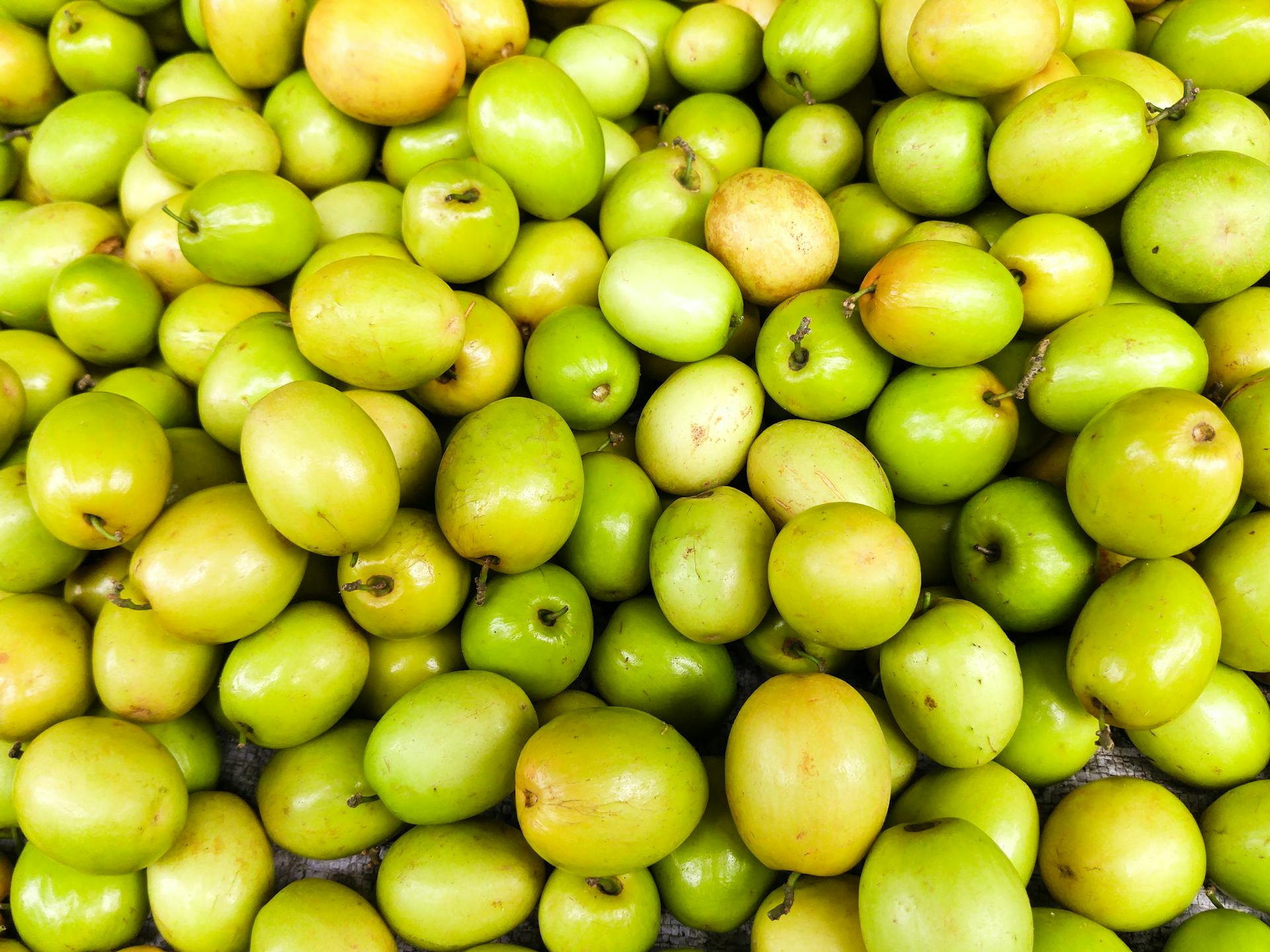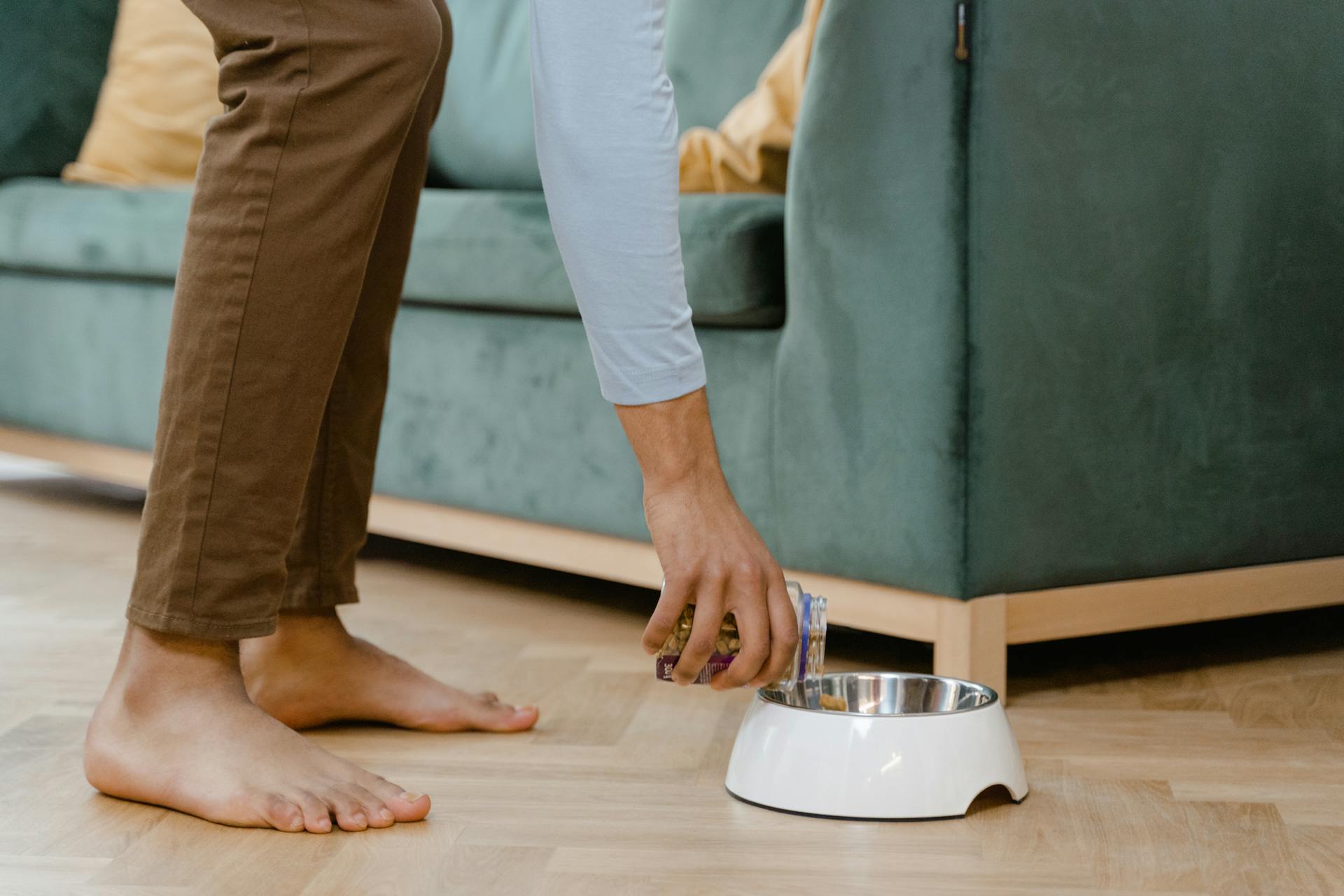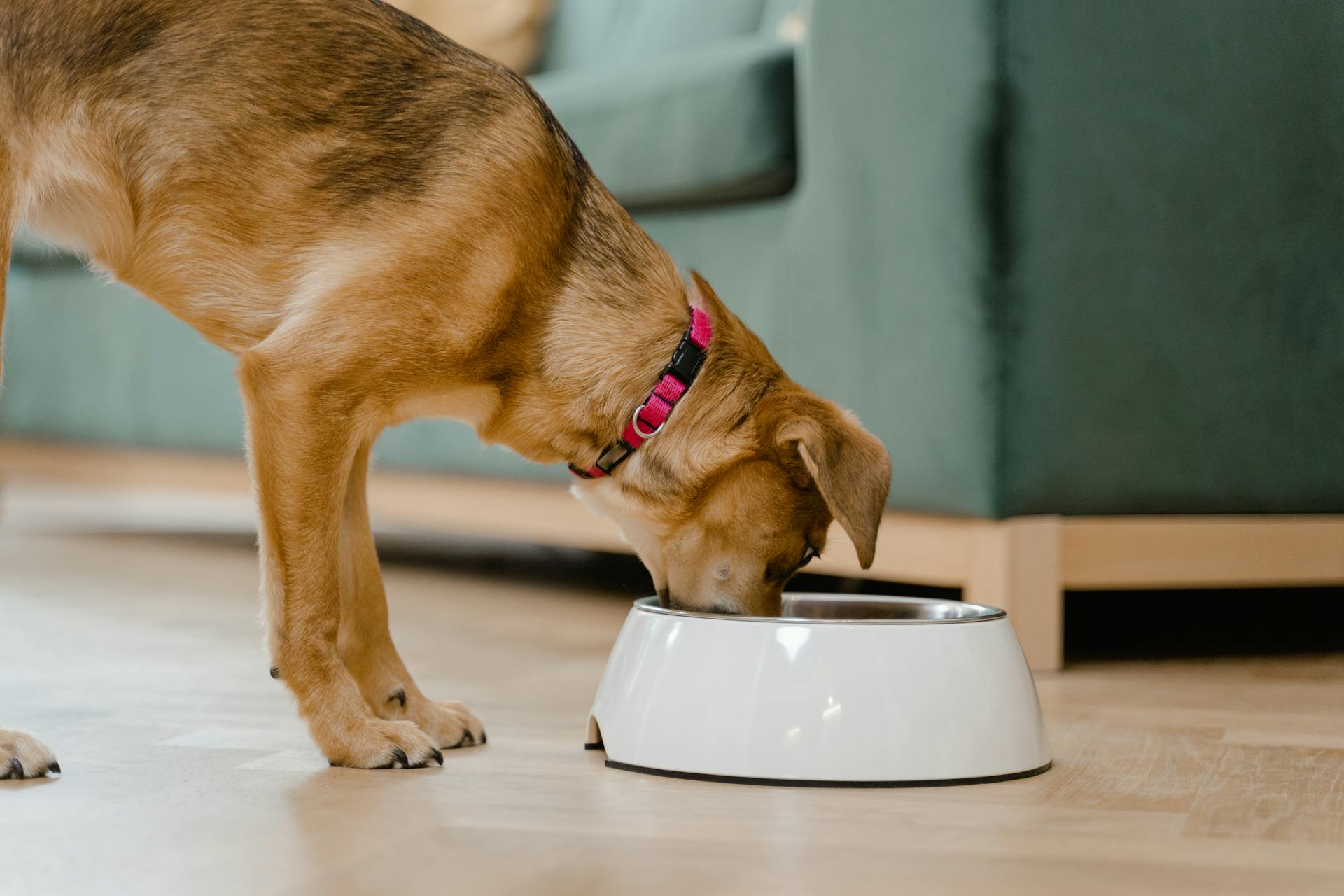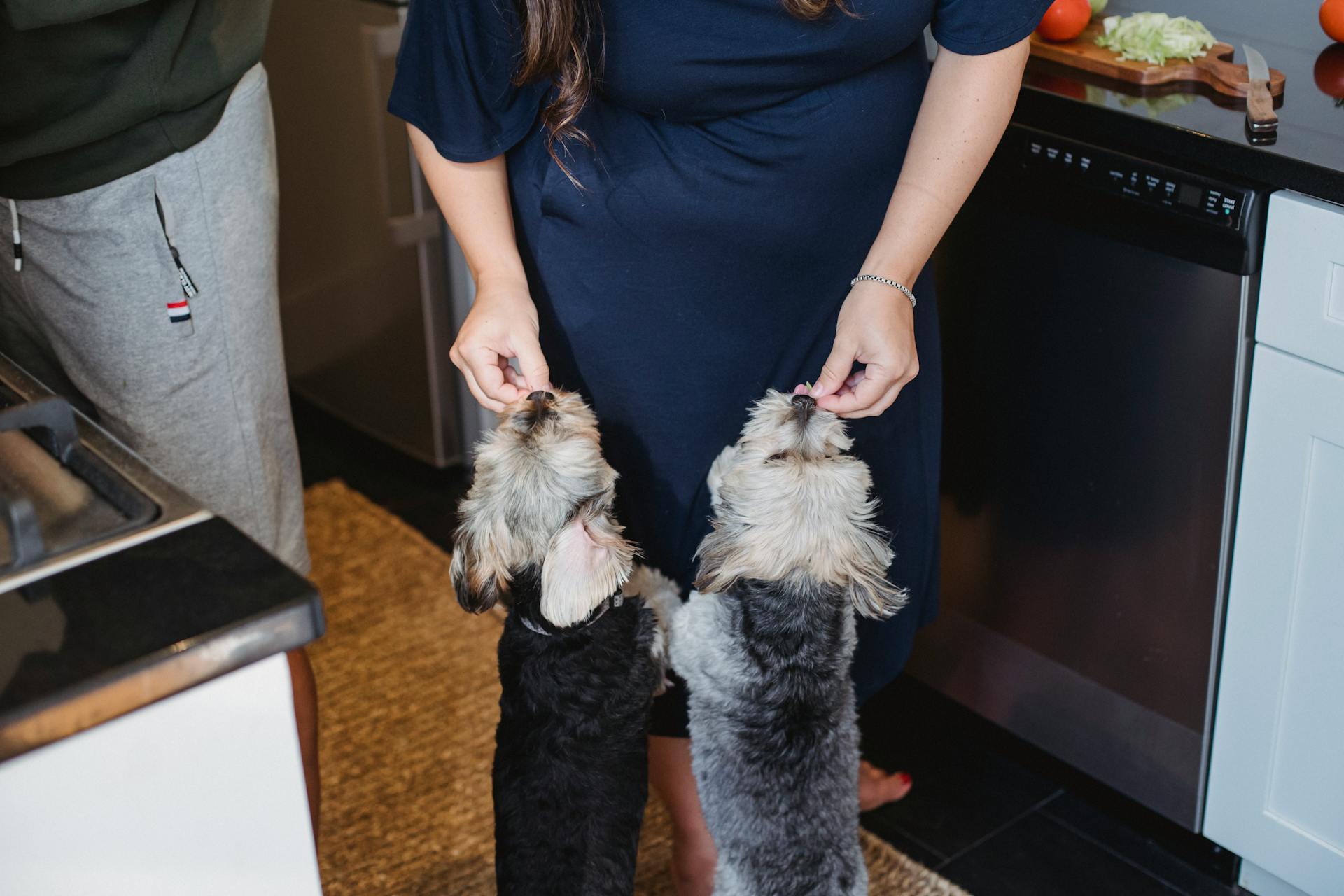
A raw food diet for dogs is a popular choice among pet owners who want to provide their furry friends with a more natural and nutritious way of eating. This type of diet consists mainly of uncooked meats, bones, fruits, vegetables, and sometimes supplements.
Raw dog food can be homemade or store-bought, and it's essential to ensure that the ingredients are fresh and safe for consumption. A typical raw dog food recipe might include 50-70% meat, 10-20% bone content, and 10-30% fruit and vegetable content.
One key benefit of a raw diet is improved digestion, which can lead to fewer digestive issues in dogs. This is because raw foods are easier for their bodies to process than cooked or processed foods.
Raw Food Diet Basics
Cooking meat for your dog removes much of its nutritional value.
Your dog is designed to get the most nutrition from raw food.
Raw food diet is a far better option than highly processed kibble.
Cooked homemade dog food is still an improvement over commercial kibble, but it's not as nutritious as raw food.
Barf Model and Recipes
The BARF model is a great starting point for creating a balanced raw food diet for your dog. The recommended guidelines consist of 70% muscle meat, 10% raw edible bone, 7% vegetables, 5% liver, 5% other secreting organ, 2% seeds or nuts, and 1% fruit.
Many raw diets lack essential nutrients if the specific ingredients aren't included, so it's crucial to add whole foods. Adding whole foods helps create a balanced diet for your furry friend.
You can also use recipes like the Raw Beef & Chicken Neck Dog Food Recipe: With Bone – All Life Stages or the Raw Boneless Beef & Egg Dog Food Recipe: All Life Stages as a starting point, and adjust according to your dog's needs.
If this caught your attention, see: Balanced Raw Food Diet for Dogs
Barf Model Ratio Guidelines
The BARF model ratio guidelines provide a clear framework for creating a balanced diet for your furry friend. The recommended guidelines consist of 70% muscle meat.
This high percentage of muscle meat is crucial for providing essential protein and amino acids to support overall health. Muscle meat also contains water-soluble vitamins that are vital for energy production.
See what others are reading: Raw Food Diet for German Shepherd Dogs
Raw edible bone makes up 10% of the BARF diet, which may seem like a small amount but provides significant benefits. Soft, raw edible bones are an excellent source of calcium and phosphorous.
Vegetables account for 7% of the BARF model ratio guidelines, adding fiber and essential nutrients to your dog's diet. The remaining percentages include liver at 5%, other secreting organs also at 5%, seeds or nuts at 2%, and fruit at just 1%.
For another approach, see: Barf Food for Dogs
Meat Recipe (Adult)
Rabbit is a great choice for dogs with food sensitivities and can be used as part of an elimination diet to identify what your dog is sensitive to.
You can feed rabbit pieces to your dog or chop it up with a cleaver, then add chopped organs for texture. Some dogs like chunks while others don't mind.
Pork has great advantages in a raw diet, being very digestible and higher in omega-3 fatty acids if pasture raised. It's also high in vitamins, especially vitamin E.
Whole fish is a great addition to your dog's diet, high in omega-3 fats and containing important nutrients like protein, calcium, selenium, and niacin.
You can feed pork with fish to balance out the fats and provide complete nutrition for your adult dog.
You might like: How Much Does a Great Pyrenees Eat
Beef & Egg Recipe for All Ages
I've had great luck with raw dog food recipes that incorporate eggs for a boost of protein and nutrients. The Raw Boneless Turkey & Egg Dog Food Recipe is a great example.
Eggs are an easy addition to your dog's raw food diet, and if you can get free-range eggs, even better. Most supermarkets carry them now, but I'm still wary - some egg cartons proudly proclaim "Vegetarian Diet", which means the chickens weren't allowed to hunt and peck outside for worms and bugs.
To ensure you're getting high-quality eggs, consider buying directly from farmers' markets or the farm itself. Those with laying hens often have a simple sign saying "Eggs For Sale."
For a boneless beef recipe that meets AAFCO minimum nutrition requirements for all life stages, including puppies, try adding bone meal as a supplement. Bone meal will supply the extra minerals puppies need.
Here's a quick rundown of what you'll need to add to your raw dog food recipes:
- Bone meal (or seaweed calcium for adult dogs)
- Powdered bone (optional)
Note: Seaweed calcium has higher bioavailability, so don't give it to puppies.
Choosing the Right Ingredients
The staple of your dog's diet is meat with a fat content between 10% and 20%. This means you should look for packaged meat that says 80%, 85% or 90% lean.
Buy from local farmers, butchers or abattoirs if possible, as this makes it easier to get a selection of organs and various types of meat. However, supermarket meats are okay too.
Avoid genetically-modified products (GMO) by choosing organic produce and meats that are free range, grass-fed or organic. This ensures the food is cleaner for your dog's health.
Remember, it isn't necessary to make all changes at once. Start with small adjustments when you can, and eventually, making your own raw dog food will become second nature.
Is Meat Good?
Meat can be a nutritious addition to your dog's diet, but only if it's handled and prepared properly.
Dogs are natural carnivores that can digest raw meat, but uncooked meat can harbor bacteria like salmonella, E. coli, and Listeria, which cause foodborne illnesses.
You might like: Is Red Meat Good for Dogs
A small amount of raw meat that falls on the floor while cooking is unlikely to harm your dog, but monitoring them for signs of illness is still important.
The Centers for Disease Control and Prevention and animal nutrition experts do not recommend feeding a raw food diet for dogs.
Choosing the Best Ingredients
The staple of your dog's diet is meat, and you want to choose high-quality options that are free from antibiotics and growth hormones.
Buy the best quality meat, poultry, eggs, and produce you can afford, as it's a long-term commitment to your dog's health. Remember, this is not just about what you feed your dog today, but also about their overall well-being in the future.
Organic means that the food has been grown without the use of harmful pesticides or GMO seeds, making it cleaner and better for your dog's health.
Avoid genetically-modified products (GMO) as much as possible by opting for organic produce instead.
Intriguing read: What Is a Raw Meat Diet for Dogs

You should look for meat with a fat content between 10% and 20%, which means packaged meat should say 80%, 85%, or 90% lean.
If you can't find high-quality ingredients locally, consider shopping at the supermarket – just make sure to choose options that meet your standards.
Some dog owners are lucky enough to have a local farmer or butcher who can provide them with a selection of organs and various types of meat. Building a rapport with your butcher can also help you get what you need quickly and easily.
Here's a quick guide to look for when choosing high-quality ingredients:
By following these guidelines and choosing high-quality ingredients, you can provide your dog with the best possible nutrition for a happy and healthy life.
Can Eat Eggs?
Dogs can absolutely eat raw eggs, which are full of nutrients like folate and riboflavin.
Eggs are a great source of iron for dogs, but it's essential to limit them to a few times a week to avoid any potential issues.
Too much egg white can cause a biotin deficiency in dogs.
Benefits and Health
Raw food diets have numerous benefits for dogs. They tend to have healthier skin and coats due to increased moisture and healthy fats.
Dogs on raw diets are less likely to suffer from allergies because they contain fewer ingredients. A study at the University of Helsinki found that puppies fed raw food were less likely to develop canine atopic dermatitis compared to those fed kibble.
Raw dog food contains naturally occurring enzymes that help protect gums and teeth, unlike highly processed foods like kibble that can cause unhealthy bacterial growth.
Discover more: Dental Health Diets for Dogs
Skin and Coat Health
Dogs fed a raw diet tend to have healthier skin and coats than dogs on other diets.
The increased moisture and healthy fats found in raw food are likely responsible for this improvement.
Raw diets may be less likely to cause allergies due to fewer ingredients.
A recent study at the University of Helsinki showed that puppies fed raw food are less likely to grow up to suffer from canine atopic dermatitis compared to puppies fed kibble.
Gut health affects skin health, so it's no surprise that dogs on a species-appropriate raw diet have healthier skin and shinier coats than those on other diets.
Curious to learn more? Check out: What Food Is Good for Dogs Skin and Coat
Better Dental Health
Kibble may seem like a convenient option for your dog's dental health, but it's really not effective at cleaning their teeth. Dry dog food manufacturers claim it helps, but eating crackers would be just as good.
Highly processed foods like kibble contain high levels of starches and sugars that can cause unhealthy bacterial growth in your dog's mouth.
Raw dog food contains naturally occurring enzymes that help protect gums and teeth. These enzymes are a big reason why raw diets can be so beneficial for your dog's dental health.
Feeding recreational raw bones a few times a week is another great way to keep your dog's teeth clean while also providing jaw exercise and mental stimulation.
Related reading: Soft Food for Dogs with No Teeth
Frequently Asked Questions
Is the raw food diet good for dogs?
Unfortunately, a raw food diet for dogs poses significant health risks due to potential nutritional deficiencies, bacterial contamination, and gastrointestinal complications. Consult with your veterinarian before making any changes to your dog's diet.
Do dogs on a raw food diet live longer?
Dogs on a raw food diet may live up to 3 years longer than those eating kibble. Research suggests a potential link between raw diets and increased lifespan in canines.
What is the best raw meat for dogs?
For a balanced diet, dogs should eat muscle meat like hamburger or chicken, along with organ meats such as heart, liver, and kidneys. Whole fish and raw meaty bones are also essential components of a nutritious raw dog food diet.
Why don't vets recommend a raw diet?
Vets often advise against raw diets due to the risk of pathogenic bacteria from microorganisms in meat and eggs. This risk is similar for both human consumption and pet food, making a balanced cooked diet a safer choice for your furry friend's health.
Is it OK for dogs to eat meat everyday?
While dogs do love meat, a diet consisting only of meat is not suitable for their health. A balanced dog food should include protein-rich recipes along with other essential nutrients for optimal growth and strength.
Sources
- https://www.petmd.com/dog/nutrition/can-dogs-eat-raw-meat
- https://perfectlyrawsome.com/raw-feeding-knowledgebase/biologically-appropriate-raw-food-barf-adult-dogs/
- https://www.dogsnaturallymagazine.com/raw-dog-food-recipes/
- https://wefeedraw.com/blog/raw-dog-food-for-beginners
- https://www.stellaandchewys.com/blogs/articles/raw-food-diet
Featured Images: pexels.com


